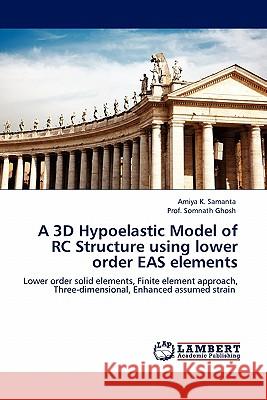A 3D Hypoelastic Model of Rc Structure Using Lower Order Eas Elements » książka
A 3D Hypoelastic Model of Rc Structure Using Lower Order Eas Elements
ISBN-13: 9783844331868 / Angielski / Miękka / 2012 / 260 str.
A 3D Hypoelastic Model of Rc Structure Using Lower Order Eas Elements
ISBN-13: 9783844331868 / Angielski / Miękka / 2012 / 260 str.
(netto: 337,33 VAT: 5%)
Najniższa cena z 30 dni: 354,20
ok. 10-14 dni roboczych
Bez gwarancji dostawy przed świętami
Darmowa dostawa!
This investigation presents a formulation of hypo-elasticity based RC beam /frame model with bond-slip. Details of the constitutive model and analysis method used are provided. A procedure has been described to carry out three-dimensional analysis considering both geometrical as well as material nonlinearity for simply supported RC beams and substitute frames employing finite element technique, which uses 8-noded isoparametric hexahedral element HCiS18. Enhanced assumed strain (EAS) formulation has been utilized to predict load-deformation and internal stresses both in the elastic as well as nonlinear regime. It models the composite behaviour of concrete and reinforcements in rigid /perfect bond situation and their mutual interaction in bond-slip condition considering continuous interface elements at the material level. An attempt has been made to reduce the gap significantly between the results found experimentally and numerically using the proposed model and the computer code developed for the purpose. The results of the analysis are presented, discussed and compared with a few benchmark experimental results.
This investigation presents a formulation of hypo- elasticity based RC beam /frame model with bond- slip. Details of the constitutive model and analysis method used are provided. A procedure has been described to carry out three-dimensional analysis considering both geometrical as well as material nonlinearity for simply supported RC beams and substitute frames employing finite element technique, which uses 8-noded isoparametric hexahedral element HCiS18. Enhanced assumed strain (EAS) formulation has been utilized to predict load- deformation and internal stresses both in the elastic as well as nonlinear regime. It models the composite behaviour of concrete and reinforcements in rigid /perfect bond situation and their mutual interaction in bond-slip condition considering continuous interface elements at the material level. An attempt has been made to reduce the gap significantly between the results found experimentally and numerically using the proposed model and the computer code developed for the purpose. The results of the analysis are presented, discussed and compared with a few benchmark experimental results.











